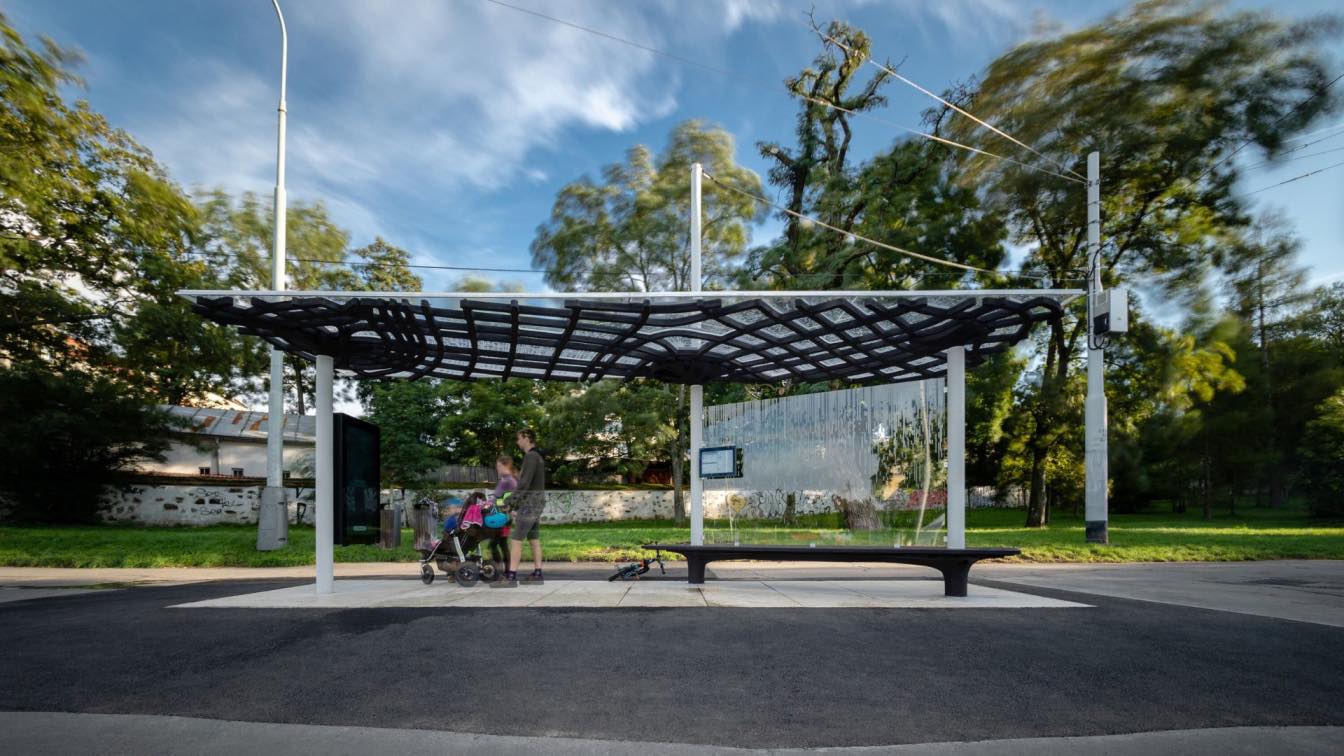The innovative Czech company So Concrete, which is successfully developing the field of robotic construction technologies, designed and realized the project of the unique Výstaviště tram stop in Holešovice, Prague. The construction of the stop uses the natural principles of internal force distribution or pressures and tensions in the structure, and the resulting design is not only unique, but above all maximally efficient. Compared to conventional technologies, this approach saves up to 60% of material, and in terms of economics and sustainability, robotic 3D printing of high-performance concrete can be considered the technology of the future. This Prague tram stop, with a minimal share of human labour, is So Concrete's first intervention in the field of urban furniture.
A bench and information panels complete the stop. It is, therefore, a comprehensive solution for the entire space. The aim was to show the functionality of the technology and the high aesthetic added value.
The location was not chosen by chance, Prague is a modern metropolis with highly developed public transport. The location of the Výstaviště tram stop near the Stromovka park is located in the Prague 7 district, which is perceived as a progressive, modern and creative district, home to a number of artistic and cultural institutions.

The design
The parametric design of the tram stop, the location, the shapes of the ribs and the columns – all make maximum use of the effectiveness of nature-proven solutions. Záviš Unzeitig, designer at So Concrete, explains how the design process inspired by natural influences works: "Already during the design phase, the structure is statically analysed, and with the help of topological optimization, it is then possible to reduce the volume of material used. At the same time, the aesthetic qualities and structural requirements are maintained. The resulting morphology of the ribs reflects the actual behavior of the structure under load and thus directly shows the forces that take place in it. Thanks to the optimization, we were able to remove places with less usability from the structure and save 60% of the material. The result is a perforated fine structure that can withstand the same load as a solid concrete slab."
The digital process
The stop design was developed using a digital workflow based on parametric design in Grasshopper (Rhino). “We use this framework to design our own software tools that cover processes ranging from geometry generation, topological optimization, static analysis, 3D slicers, and inverse kinematic solvers to post-processors. Our focus on creating custom digital solutions allows us to quickly adapt to a wide range of standard file formats and geometry types. Working closely with our customers to optimize the input digital models for our production process enables a quick transition from idea to physical object,” explains Dimitry Nikitin, robotic engineer at So Concrete. For the static verification of the design of the stop structure and its final appearance to be completely independent, the leading engineering company Stráský, Hustý a partneři, was approached for validation.

Production and materials
The stop is composed of several structural segments, for which different types of concrete and 3D printing approaches were used. The roof and the bench were manufactured using robotic 3D printing. The material – concrete – was chosen according to function and load. For example, steel-fiber reinforcement was not used for the bench seating area, as opposed to the roof, which contains this reinforcement. To produce the column heads, the robot milled and printed the moulds into which the final heads were subsequently printed.
Technology for the future
So Concrete technology is based on three pillars: topological optimization, ultra-high-performance concrete (UHPC) and robotic 3D printing. Thanks to the integration of these principles, the basic structure of the stop could be produced within 24 hours. The topological optimization allowed more than half of the material to be saved and to achieve natural aesthetics. The properties of UHPC make it possible to manufacture such subtle self-supporting structures using a minimum amount of steel. Robotic 3D printing not only brings the advantage of saving human labour, but also the possibility of producing such complex shapes without the need to use moulds or formwork.















About digital concrete
State-of-the-art digital techniques and processes allow concrete to be used in new ways which help build new structures and infrastructure more efficiently and cost-effectively. Recent developments show that new inventions such as 3D printing of concrete structures and formwork are not only possible, but likely to dominate construction technology in the coming years. 3D printing has the potential to produce building elements with complex shapes in particular. This can be achieved either by printing individual components or by creating formwork or moulds that will allow the structure to be shaped and perfected more. Automated manufacturing is boosting off-site manufacturing, which is seen as key to increasing productivity across the construction industry. Concrete elements such as floors and walls are produced in controlled conditions in factories using digital technologies, then transported and quickly assembled on site. This reduces construction time, saves costs and promotes sustainability.
About studio
So Concrete is a Czech innovative company focused on digital concrete. Using robotic additive manufacturing (simplified 3D printing) and topological optimization, it designs and implements design objects and structures from ultra-high-performance concrete (UHPC). Robotic production in the construction industry has three main advantages: material saving, aesthetic value and environmental friendliness.
So Concrete focuses on 3D printing ultra-high-performance fiber-reinforced concrete (UHPFRC) and has its own unique formulas. In their development, the company cooperates with the leading manufacturer of building materials, Master Builders Solution. Testing and further development take place, among other things, in cooperation with the Department of Concrete and Masonry Structures at the Czech Technical University. So Concrete has a certified printable mixture with a compressive strength of 130 MPa.

